
* The Boeing B-29 was, in effect, a next-generation follow-on to Boeing's classic B-17 Flying Fortress. It was one of the top-priority development programs for the US during World War II; it didn't go into service until late in the war, but after teething problems, it became of the weapons that defeated Japan. It also flew combat missions in the Korean War, if not with as much distinction.
* The B-29 originated as a Boeing-funded study for an advanced follow-on of the company's B-17 Flying Fortress bomber, featuring tricycle landing gear and a pressurized cockpit. The concept, which was designated the "Model 334", was presented to the US Army Air Corps (USAAC) in March 1938. The USAAC had no particular requirement for the aircraft, but encouraged Boeing to keep on working on the idea.
Boeing did so, coming up with improved designs, leading to the "Model 334A" in mid-1939; a mockup was completed by the end of the year. War broke out in Europe in September 1939, with high US officials were expecting that the US would be dragged into the conflict sooner rather than later, and America was beginning a military buildup. An advanced bomber with high performance and long range seemed like it would be a nice thing to have, with the USAAC issuing a request for studies of a "Very Long Range (VLR)" bomber in the fall of 1939.
A requirement was issued by the USAAC in January 1940, aggressively specifying a speed of 640 KPH (400 MPH), a range of 8,600 kilometers (5,300 miles), and a bombload of 900 kilograms (2,000 pounds). The specification was revised in April to reflect lessons learned from the conflict in Europe, adding more defensive armament, armor, and self-sealing fuel tanks.
Lockheed submitted the "XB-30", a bomber derivative of the Constellation transport then under development; Douglas offered the "XB-31", a bomber derivative of the DC-4 transport then in the works; and Consolidated provided a design designated the "XB-32", with some features along the lines of the Consolidated B-24 bomber. Boeing of course handed the USAAC the company's latest bomber concepts, and in late August 1940, the USAAC ordered two flight prototypes, plus a static-test airframe, of the latest iteration of Boeing's advanced concept, designated the "Model 345", to be given the military designation of "XB-29". A third flight prototype was ordered late in 1940. The Air Corps also pursued development of the XB-32 as a backup plan.
The first XB-29, unarmed and painted olive drab, performed its initial flight on 21 September 1942 with Boeing test pilot Eddie Allen at the controls. However, well before that, in January 1942, the US Army Air Forces (USAAF, which superseded the Air Corps in June 1941) had ordered 14 "YB-29" evaluation aircraft and 500 production machines. By the time of the initial flight of the XB-29, the production orders had shot up to 1,664 machines, to be built by a massive production pool involving a total of 60 factories. Final assembly was to be at three huge plants, including a Boeing plant in Wichita, Kansas; a Martin plant in Omaha, Nebraska; and a Bell plant in Marietta, Georgia. Ultimately, a fourth facility would be set up by Boeing at Renton, Washington, north of Seattle. Tooling up for production would prove a monster job.
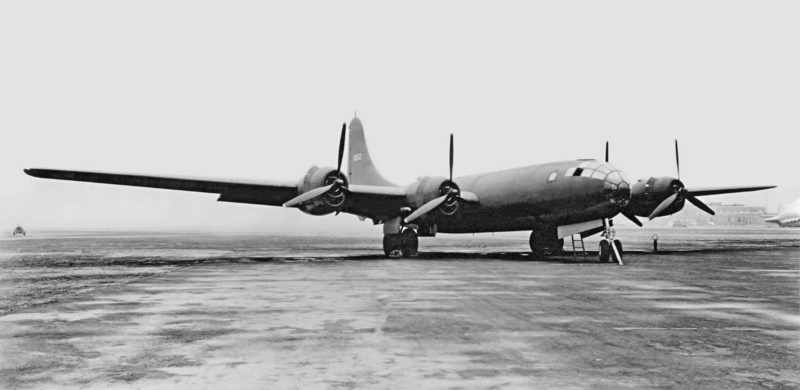
Getting the advanced B-29 to work right wasn't trivial either. The first XB-29 prototype had to be grounded for two months after an engine fire in December 1942, the Wright Duplex Cyclone engines -- a new design that was pushing the limits of available technology -- proving overly inclined to overheat and burst into flames. A second XB-29 prototype was soon in the air, but on 18 February 1943, it too suffered an engine fire. Allen couldn't keep the machine in the air and it crashed into an industrial site, killing the entire crew and twenty bystanders who just happened to be in the wrong place when the aircraft went down.
The incident unsurprisingly led to a congressional investigation. Missouri Senator Harry Truman's Special Committee to Investigate the National Defense Program concluded that Wright had shipped dodgy engines, having been heavily pressured by the USAAF to get engines to Boeing as soon as possible.
Nonetheless the program continued, with a third prototype flying, followed by 14 "YB-29" service-test aircraft, built at Wichita, the first performing its initial flight in June 1943. The first production machines were delivered in early 1944. They left something to be desired in terms of workability, but they were still put into service. There was a war on; the problems would have to be fixed as the planes went into combat.
BACK_TO_TOP* The B-29 was a marvel of technology when it was introduced, arguably the most advanced long-range bomber in existence. It was an all-metal aircraft, constructed mostly of aircraft aluminum alloy, of generally conventional arrangement. It had a mid-mounted wing fitted with four powerful Wright R-3350 Duplex Cyclone 18-cylinder two-row air-cooled radial engines with twin General Electric turbochargers. Each engine provided 1,641 kW (2,200 HP) and drove four-bladed Hamilton Standard propellers with a diameter of 5.05 meters (16 feet 7 inches). Early YB-29s had three-bladed propellers.
The XB-29 used the R-3350-13 engine variant, while the YB-29s used the R-3350-21, and production B-29s used the R-3350-23. The B-29's performance was almost in a league with a fighter's, and it was able to operate at altitudes that few fighter aircraft could reach. The aircraft's handling was, with some caveats -- discussed later -- regarded as pleasant.
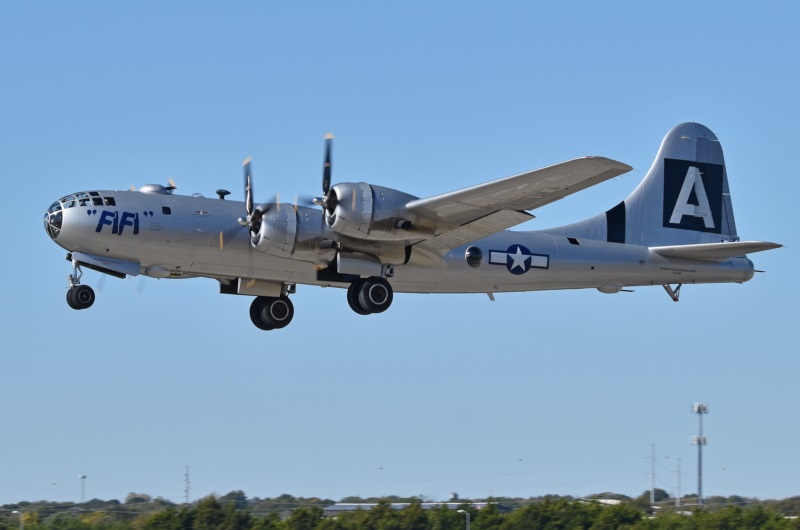
There were seven fuel tanks in each outer wing, four in each inner wing, and four bomb bay tanks, with a total capacity of 30,957 liters (8,168 US gallons). After early production, four tanks were added to the wing center section, raising total fuel capacity to 35,700 gallons (9,438 US gallons).
The B-29's wing area was relatively small to provide high speed, resulting in high wing loading that meant dangerously long take-off runs and even more dangerously "hot" landing speeds, but this was mitigated by the use of large electrically-actuated "Fowler-type" flaps, extending well behind the wing when deployed, that increased the wing area by 20%. Its landing speed was still about 255 KPH (160 MPH), twice that of a B-17. The wings featured de-icing boots.
The Superfortress featured electrically-driven tricycle landing gear, with all gear assemblies featuring twin wheels, the nose gear retracting backwards, and the main gear retracting forwards into the inner engine nacelles. There was a hydraulically-operated bumper under the tail to protect the tail from ground strikes on a steep take-off.
A streamlined "greenhouse" style cockpit was fitted. Defensive armament included four remotely-controlled barbettes -- including one forward and one to the rear on the top of the aircraft, and one forward and one to the rear under the aircraft -- and a manned tail turret. All four barbettes originally had twin 12.7-millimeter (0.50-caliber) M2 Browning machine guns; in response to operational experience, the forward top barbette was later up-gunned to four Brownings, to deter frontal attacks. Early YB-29 evaluation machines, incidentally, had retractable turrets with periscopic sights, that scheme proving unsatisfactory.
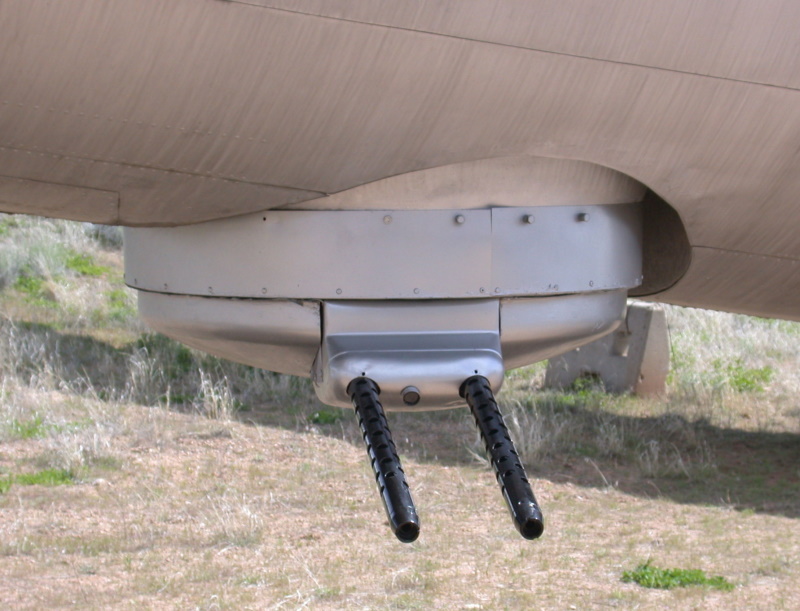
Gunners controlled the barbettes from sighting blisters, using reflector sights and a sophisticated electronic control system that automatically switched control from, say, a top turret to a bottom turret as the gunner tracked a target diving past, and allowed gunners to swap turret control among each other should a gunner be disabled. There were two sighting blisters on the spine of the aircraft and a sighting blister on each side of the rear fuselage. The system demanded more electrical power than had been originally designed into the aircraft, demanding that more generator power be installed and raising aircraft weight.
The tail turret featured twin Brownings plus a 20-millimeter cannon. The 20-millimeter cannon was often removed in service, it seems the big problem with it being that the trajectory of its shells didn't follow that of the machine guns, making aiming problematic. It was eventually deleted from production. Some B-29s apparently had three Brownings in the tail position; it may have been a field improvisation.
The complexity of the defensive gunnery system was such that there were worries it might not prove practical, and so one B-29 was modified with a manned turret system. This machine featured two dorsal turrets and two belly "ball" turrets, each with twin Brownings -- plus a flexible Browning in a beam position on each side, and a Browning in a pod on each side of the nose. This armament fit, of course, was not adopted for service. It is unclear what happened to the modified B-29.
The Superfortress had two large bomb bays. These had a sequence release system so that bombs would be dropped from the front bomb bay, then the rear, then the front, and so on to ensure that the aircraft maintained trim. Since pressurizing the bomb bays would have been troublesome at best, the bomber's forward and aft pressurized crew compartments were connected by a crawlway tunnel across the roof of the bomb bays.
___________________________________________________________________
BOEING B-29 SUPERFORTRESS:
___________________________________________________________________
wingspan:
43.05 meters (141 feet 3 inches)
wing area:
161.27 sq_meters (1,736 sq_feet)
length:
30.18 meters (99 feet)
height:
9.02 meters (29 feet 7 inches)
empty weight:
31,815 kilograms (70,140 pounds)
MTO weight:
56,245 kilograms (124,000 pounds)
max speed at altitude:
576 KPH (358 MPH / 311 KT)
service ceiling:
9,710 meters (31,815 feet)
range:
5,230 kilometers (3,250 MI / 2,825 NMI)
___________________________________________________________________
By the standards of the time, the B-29 had sophisticated navigation and bombing gear, including a Long-Range Air Navigation (LORAN) receiver and an AN/APQ-13 radar bombing set. The AN/APQ-13 used a retractable radome mounted in between the bomb bays. Later on, B-29s carried the AN/APQ-7 Eagle radar bombing set, with better resolution, featuring a wing-shaped antenna in the place of the retractable radome.
There were typically crewmen on the B-29, comprising pilot, copilot, bombardier, navigator, flight engineer, radio operator, radar operator, central fire control gunner, left side gunner, right side gunner, and tail gunner. The first six crewmen were housed in the forward pressurized cabin. The next four were housed in the rear pressurized cabin. The tail gunner was in a separate pressurized compartment in the tail. Later in the war, the crew size was occasionally increased to 13 with the addition of two radar/radio operators to man the radar and electronic countermeasures equipment.
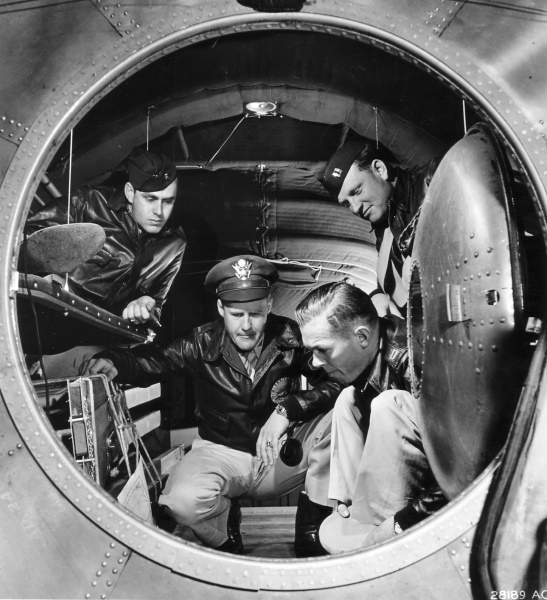
Only very early B-29 production was painted, with olive drab on top and light gray on the bottom. The rest were delivered in natural metal finish.
* Incidentally, the evaluation YB-29s had an extensive career as test and trials aircraft. One YB-29 was experimentally fitted with Allison V-3420 24-cylinder liquid-cooled inline engines, providing 1,567 kW (2,100 HP) each, and redesignated "XB-39". The V-3420 was actually a "W" configuration engine, two Allison 12-cylinder V-1710 engines mated side-by-side, coupled to a common driveshaft. The XB-39 did demonstrate improved performance, but not enough to justify production -- and the V-3420 never entered production anyway.
BACK_TO_TOP* As the USAAF began to bring the B-29 into operational service in mid-1944, the obvious question arose of how it would be used. All B-29s assigned to combat were sent to the Far East to support the war on Japan, the belief being that the B-17 and Consolidated B-24 were sufficient to pursue the war on Germany.
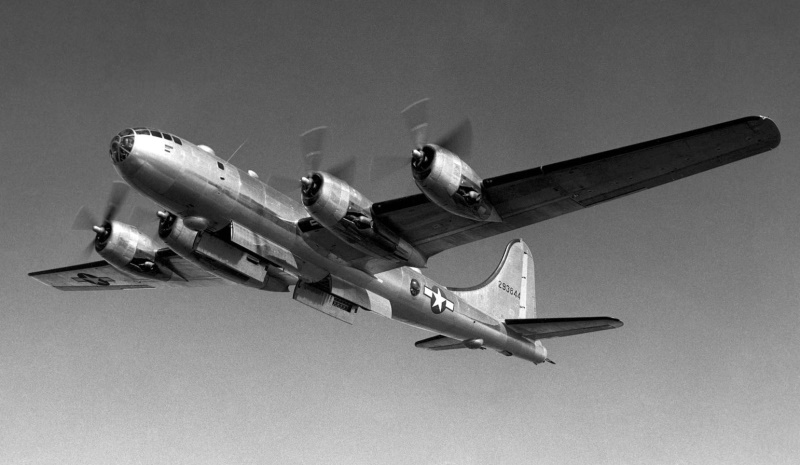
At the time, the only way the B-29 could reach the Japanese mainland at that time was from regions of China not occupied by the Japanese, and the only way to build and supply such advance bases was by a laborious and expensive airlift of supplies over the Himalayas from India. B-29s were deployed to India and, using India as a base, to Chengtu in China. From there the bombers had the range to attack Kyushu, the southernmost main island of Japan.
The air campaign from China, known as Operation MATTERHORN, did not go well. Setting up and supporting the China bases by airlift over the Himalayas was logistically impractical. In addition, since the B-29 had been rushed into service and was a very complicated machine, the necessary consequence was a lot of teething problems that took time to work out. Cabin pressurization was a headache, and engine fires were particularly troublesome; attrition and casualties from just ferrying the aircraft to their advance bases were substantial.
The results of the raids were unimpressive. Daylight precision bombing against the steel mills of Kyushu didn't do that much damage, while combat casualties were often heavy. Most significantly, eventually the Japanese army of occupation in China grew tired of the irritant of the Chengtu base and moved against it in a major land offensive. The Americans were forced to evacuate, blowing up all the supplies they had ported over the Himalayas at so much cost and effort.
However, as embarrassing as that was, it didn't really matter. Well before that, the Mariana Islands had fallen into American hands, providing a base from which B-29s could fly to perform raids over most of the Japanese home islands. In late November 1944, B-29s began their first raids against Tokyo and other Japanese targets, operating generally in daylight using precision bombing techniques with high-explosive ordnance. The results were also poor. Bad weather kept accuracy low, and the B-29 crews operating at very high altitudes encountered a bizarre and unknown phenomenon: winds of up to 240 KPH (150 MPH). Flying with the wind make proper aiming impossible, while flying against the wind made the bombers easy targets for long-range anti-aircraft artillery.
Today we know this high-altitude wind as the "jet stream", but since aircraft had never routinely flown so high before, it was a complete surprise to American pilots and meteorologists. The Japanese, incidentally, did know about the jet stream, and would use it later on in 1944 to conduct a bizarre offensive against the US West Coast -- sending up balloons carrying incendiary bombs to float across the Pacific and hopefully cause forest fires. The balloons caused some excitement, but did little damage.
In any case, the poor results of the Superfortress raids led to the installation in January 1945 of a new field commander: General Curtis LeMay. LeMay was the best the USAAF had to offer. He was a fine bomber pilot with a keen mind and organizational abilities, who combined a willingness to experiment with a remarkable ability to assess the overall scheme of things. LeMay was fully aware that research had given him a new, savagely promising, approach to laying siege to Japan by air.
* USAAF policy in the early part of the war had strictly adhered to the concept of daylight precision bombing. There was a distaste for deliberate attacks against civilian populations. However, given the crude technologies of the time, USAAF bomber raids in Europe did in fact often lead to the destruction of densely-populated portions of European cities. It was often not possible to discriminate between valid targets and residential neighborhoods, and even the best bombsights were by our standards highly inaccurate. Bad weather conditions led to blind bombing whose accuracy was even worse.
These problems were understood and accepted. At the same time, the British Royal Air Force was conducting highly indiscriminate attacks against German population centers at night using incendiary weapons, with the express purpose of destroying residential areas and inflicting civilian casualties. While there were some protests in both America and Britain against this policy, RAF fire-bombing raids continued up to the end of the war against the Nazis.
Given this example, some American officials considered the possibility of using the USAAF to conduct similar operations. Early in the war, American engineers had evaluated several currently-available incendiary weapons, and developed one of their own: the M-69 firebomb.
The M-69 was a simple, clever weapon. It looked like an elongated tin can, and weighed only 2.3 kilograms (6.2 pounds). As handling such a small weapon was inconvenient -- more to the point, dropping quantities of them from high altitude would be wildly inaccurate -- it was designed to be incorporated into an "aimable cluster", a type of cluster munition that contained 38 of the M-69 firebombs.
The aimable cluster would be dropped from high altitude and then break apart at about 900 meters (2000 feet), scattering its M-69s. Each M-69 would then eject a long strip of cloth to orient it, and crash nose-first into buildings below. On impact, it would then ignite its payload of jellied gasoline -- napalm -- which would shoot out of the tail of the bomb in a burning jet. Under optimum conditions, this jet could travel 45 meters (100 feet).
The problem with the M-69 was its small size; it could not penetrate the roofs of solidly-constructed buildings. However, there was one set of targets for which some of the weapon's designers felt it was ideally suited: the dense cities of Japan and their lightly-constructed buildings. Japanese cities were congested, and the predominant form of building was a two-story wooden house. The great Tokyo earthquake and fire two decades earlier had demonstrated how vulnerable such cities were to flame.
In addition, the organization of Japanese industry made the contemplation of burning their cities more intriguing: not only were Japanese factories usually embedded in residential areas, but Japanese manufacturing in general was highly distributed, oriented around a large proportion of small or even household-sized subcontractors. If it was hard to distinguish between military and civilian facilities in Europe, it was almost impossible in Japan.
Such thinking led to a careful analysis of the six main Japanese cities -- Tokyo, Nagoya, Kobe, Osaka, Yokohama, Kawasaki -- with their partition into "zones" that were arranged in priority of the value and vulnerability to incendiary attack. A small mock "town" consisting of a set of Japanese and German housing structures as constructed at Dugway Proving Grounds in Utah, and then bombed with incendiaries from mid-May to mid-July 1943; the M-69 proved devastating to the Japanese structures, with further tests of the M-69 against the buildings into 1944.
* LeMay found the Dugway experiments particularly interesting, and decided the M-69 was the weapon of choice against Japan's cities. On 24 February 1945, LeMay's Superfortresses launched an incendiary attack against Tokyo. The raid did not seem to go well. The 229 B-29s in the raid were unable to assemble in force and ended up attacking their target area in a piecemeal and scattered fashion. However, casualties were light; could it be that such a piecemeal attack confused Japanese defenses? Not only that, the concentrated drop of incendiaries resulted in burning out over two square kilometers of Tokyo, a far better result than the B-29s had obtained up to that time.
LeMay grasped the pattern and came up with a new strategy. The bombers would be sent in one by one, with no intent to focus on a specific target. Instead, they would dump streams of incendiaries on a general section of Tokyo. As radar navigation was adequate for this level of accuracy, there was no reason to attack during the day, the raid could be just as well carried out at night. Since Japanese night-fighter capabilities were primitive, such a measure would enhance the safety of the raiders.
Sufficient accuracy and concentration of flame could be obtained by operating the B-29s at low level, 2,100 meters (7,000 feet). That was high enough to avoid light anti-aircraft weapons, but low enough to make use of heavy weapons difficult. To eliminate the risk of firing on each other, LeMay had the bombers' defensive armament removed. The reduced weight, as well as the low operating altitude, permitted a much heavier bombload.
On the night of 9 March 1945, the B-29s went in. The bomber crews had been apprehensive of the new tactics, finding the low altitude and removal of defensive armament worrisome. However, as they streamed in over Tokyo, they found resistance feeble; and as they dumped their loads of M-69s the fires below grew into a wall of flame. On the ground the winds were blowing at almost 50 kilometers (30 miles) per hour. The wall of fire swept across the city, causing dwellings to burst into flame from the heat of the approaching wave even before they were touched. Observers on buildings saw people in the streets light up like matches.
The fires burned themselves out by dawn. Roughly 83,000 people were dead, and over a million had lost their homes. Over 40 square kilometers (16 square miles) of Tokyo had been burned to the ground. LeMay did not intend to stop there. On 11 March, the B-29s hit Nagoya; on 13 March, Osaka; on 16 March, Kobe; on 18 March, Nagoya again. Then the fire raids stopped. LeMay was out of incendiaries, after dropping over 8,200 tonnes (9,000 tons) of them to terrible effect, burning out 80 square kilometers (32 square miles) of Japan's major cities, while impoverishing and terrorizing countless Japanese civilians. Civilian casualties following the 9 March raid on Tokyo were much less severe; Japanese authorities hadn't placed much emphasis on civil-defense measures, but became more energetic after the 9 March raid.
On the last day of the March blitz, the Emperor left the imperial palace grounds to inspect the damage to the city of Tokyo. Japanese military propaganda had proclaimed confidence in the ability of the military to defeat Japan's enemies, with considerable justification at the beginning of the Pacific War, but with growing insecurity as the ring of American steel began to draw around Japan. Now it was apparent that the best the military could do was die fighting in hopes of obtaining a peace deal on somewhat more advantageous terms than "unconditional surrender". While the Americans did not embrace death in battle with the same zeal as the Japanese, it was clear that in their own way they were just as determined, and would defeat Japan no matter what measures would be needed to do it.
LeMay had to wait on the shipment of 32,700 tonnes (36,000 tons) of incendiaries by sea before resuming his war of the cities, and that would take weeks -- but he kept his B-29s busy, performing strikes with high explosives and, with particular effect, dropping 450-kilogram and 900-kilogram (1,000-pound and 2,000-pound) mines at chokepoints in Japanese waterways. Japan, as an island nation, was dependent on imports of food to survive. In between mining and American submarine warfare and mining, the home islands were increasingly cut off and faced with starvation.
The firebombing campaign began again on 14 May, with an attack on Nagoya. After the devastation of Tokyo, the Japanese understood how vulnerable their cities were, and took civil defense more seriously, so the follow-on raids were not such exercises in mass slaughter. However, the Japanese could still do little to stop the attacks; on 23 and 25 May, Tokyo was hit again. Even in the face of stiffened Japanese resistance, the fire raids were so successful that Tokyo was written off the target list for further fire raids.
The other six cities on the list were dealt with in the same way. After these targets had been reduced to ashes, the next objective was to destroy Japan's smaller cities, and LeMay proceeded immediately to that goal. Psychological-warfare tactics were used to increasing effect. B-29s began to perform leaflet drops warning citizens that their homes would be bombed the next day, a gesture which combined a certain minimal humanitarian concern with mocking intimidation.
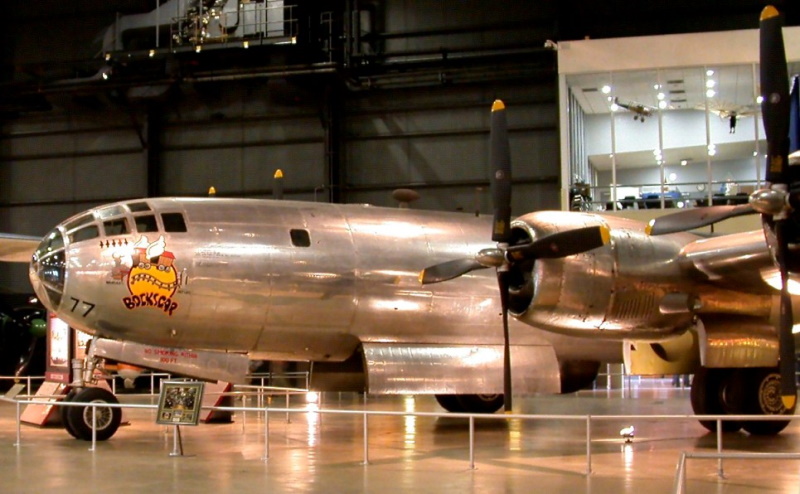
On 5 August, a B-29 piloted by Colonel Paul Tibbetts and named ENOLA GAY after his mother dropped an atomic bomb named LITTLE BOY, on the city of Hiroshima. It air-burst and leveled the center of the city, killing 70,000 people. Three days later, on 9 August, another B-29 named BOCKSCAR dropped another atomic bomb, this one named FAT MAN, on Nagasaki. In an unprecedented radio speech, on 15 August the Emperor announced Japan's surrender.
It is impossible to say that the B-29 won the Pacific War, but it is unarguable to say it made a major contribution. Following Japan's surrender, B-29s kept busy dropping desperately-needed supplies to prisoner-of-war camps all over Japanese-held territory, until the prisoners could be retrieved and repatriated.
BACK_TO_TOP* A total of 2,513 baseline production B-29s was built. Boeing also produced 1,119 "B-29A" bombers at a plant in Renton, Washington, these being externally the same as the baseline B-29, except for a modified wing center structure. After initial B-29A production, production machines were fitted with pneumatically-operated bomb bay doors that could close in less than a second, as compared to the seven seconds required for the normal hydraulically-actuated doors. Eventually, all B-29 production had the pneumatic doors. Late production B-29As had revised engine nacelles, with the oil cooler and intercoolers moved back, giving them a "weak-chin" appearance. They were accordingly called "Andy Gump" nacelles, after a comic-strip character who lacked a chin.
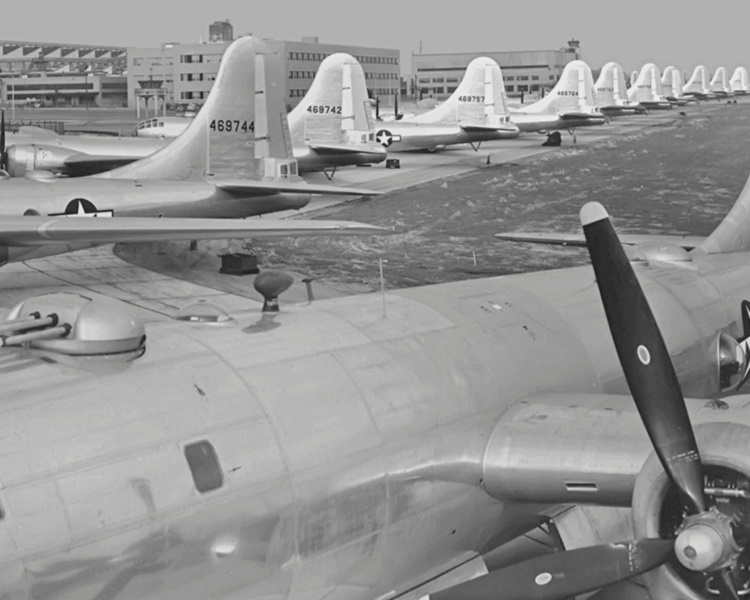
There was also a "B-29B", only built by Bell at the plant in Marietta, which was a stock B-29 -- but with all the defensive armament removed, except for the tail guns. The guns were directed by a new AN/APG-15B radar-directed automatic fire control system. The deletion of the defensive armament increased the top speed of the B-29B significantly, and reduced the number of crew.
By late in the war, earlier-production B-29s were increasingly stripped of their defensive armament as well, so it was hard to tell a B-29B from a stock B-29. A total of 311 B-29Bs was built. One, named PACUSAN DREAMBOAT, was modified after the war with R-3350-CA-2 engines with fuel injection, driving special three-bladed props, and used to set distance records.
Production of B-29s was 3 XB-29s, 14 YB-29s, 2,513 baseline B-29s, 1,119 B-29As, and 311 B-29Bs; for a total of 3,960 B-29s in all, the last one being delivered in October 1945. 2,756 of the total were built by Boeing, 668 by Bell, and 536 by Martin. Thousands more were on order when the war against Japan ended, resulting in large-scale cancellations of contracts. There had been talk of a "B-29C" with improved engines, but it was canceled as well.
* The B-29 was an excellent aircraft, with good speed, range, altitude capability, and payload, and it was adaptable to a many different roles. During 1945, 118 B-29s and B-29As were modified to a photo-reconnaissance standard and redesignated "F-13" and "F-13A" respectively. They retained defensive armament and bombing capability. After the war, in 1948, they were redesignated "RB-29" and "RB-29A".
A total of 16 B-29s was converted for air-sea rescue (ASR) and redesignated "SB-29". These machines, known as "Super Dumbos", carried a large lifeboat that could be dropped with three parachutes to rescue crews from the ocean, with a search radar mounted under the aircraft forward of the boat. They put in good service during the Korean War, but were eventually replaced by Douglas C-54s, which didn't require so much fuel.
Other Superfortresses were modified for weather reconnaissance under the designation of "WB-29", and also put in extensive service during the Korean War. There are unconfirmed tales that some of the "weather reconnaissance" Superfortresses were actually covert "signals intelligence (SIGINT)" platforms. It is known that the weather reconnaissance Superfortresses at least sometimes did carry air-sampling gear to pick up fallout from nuclear weapons tests for analysis -- more on this later.
* In the postwar period, tensions with the Soviets dramatically escalated, and so the USAF turned to inflight refueling. From 1948, 92 B-29s were converted to "KB-29M" tankers using a British-designed inflight refueling system. The tankers were stripped of all armament except the tail guns. The inflight refueling system was awkward, in effect the tanker crew letting out a hose, which was snagged by the receiver crew and plugged in.
74 B-29s were correspondingly modified as tanker "receivers", using the snag-hose system, under the designation of "B-29MR" -- originally "B-29L", though that designation wasn't actually used. They were also stripped of all armament except the tail guns, with the side sighting blisters removed on some aircraft, replaced by flush plugs with small windows. The forward bomb bay was kitted up for carrying a nuclear bomb, with the rear bomb bay accommodating a long-range fuel tank.
The scheme was only barely workable; the USAF soon went to a boom refueling system for long-range bombers, with two Superfortresses used to evaluate the boom system, not being given any special designation. Following successful evaluation, the boom system was fitted to 116 B-29s in 1950 and 1951, these machines being designated "KB-29P".
The boom system was well-suited to refueling large aircraft like bombers, since it could support high fuel transfer rates. However, the hose-drogue refueling system -- developed by Flight Refueling LTD in the UK, in which a hose was reeled out with a basket or "drogue" at the end, with the receiver aircraft mating a probe into it -- proved more useful for fighter aircraft. Some of the KB-29P boom tankers were modified to hose-drogue operation by adding a hose-drogue assembly to the end of the boom. One KB-29M was more adequately fitted out as a "three-point" hose-drogue tanker, with one refueling unit in the tail and one under each wingtip. Only one such three-point conversion was performed, being redesignated "YBK-29T", but the idea wasn't abandoned.
* At least one B-29 was converted to a cargo transport, to be redesignated "B-29K", and at least one "VB-29" VIP transport conversion was performed as well. Other Superfortresses were converted to crew trainers under the designation of "TB-29". Some sources also identify the TB-29 as a target tug, though again it seems the B-29 was on the big side for that role.
Sources mention conversions to "QB-29" target drones and "DB-29" drone controller conversions, but details are very unclear. Although B-17s were used as target drones, it's hard to find any record of B-29s used in that role. It is also hard to understand why anyone would want to use such a large aircraft as a drone controller, when a smaller, more economical aircraft would do the job as well.
It is plausible, though not supported by any good evidence, that there were notions of loading up drone B-29s with high explosive, and then using them as "cruise missiles" to attack hardened targets. In such a scenario, a DB-29 could accompany a QB-29 to a long-range target and direct the attack. Both drone B-17s and Consolidated B-24 Liberators were used as guided missiles during World War II, if not to any good effect. In any case, it doesn't appear that any B-29s were actually fitted up as cruise missiles, and may not have actually been used as drones at all. At least one B-29 was kitted up to carry JB-2 cruise missiles, the JB-2 being a copy of the German Fi 103 / V-1 "Buzz Bomb".
The US Navy obtained four Superfortresses, under the designation of "P2B-1S". It appears the Navy originally obtained them for long-range patrol, with two being fitted with a large and ugly radome for an airborne early warning (AEW) radar behind the cockpit, these two machines possibly being redesignated "P2B-2S". The Navy decided to use the PO-2 / WV-2 Warning Star -- a military version of the Lockheed Constellation airliner -- as the service's AEW platform, and the Navy ended up using the type for trials. One P2B-1S was used as the carrier aircraft for the Douglas D-558-2 Skyrocket experimental rocket aircraft, this Superfortress being named FERTILE MYRTLE. The Skyrocket was the first aircraft to break Mach 2.
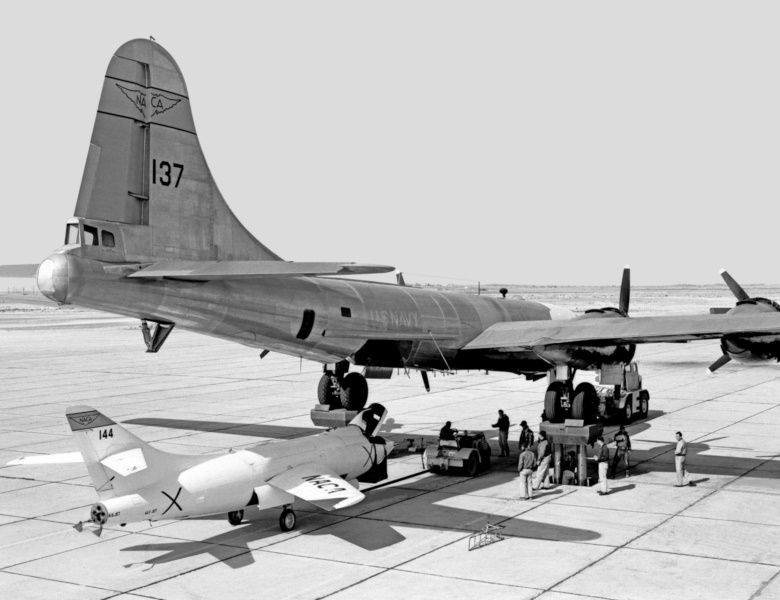
Other Superfortresses used for trials included:
A handful of B-29s used for test and trials were redesignated "EB-29" -- the "E" standing for "exempt", it appears meaning not used for regular duties.
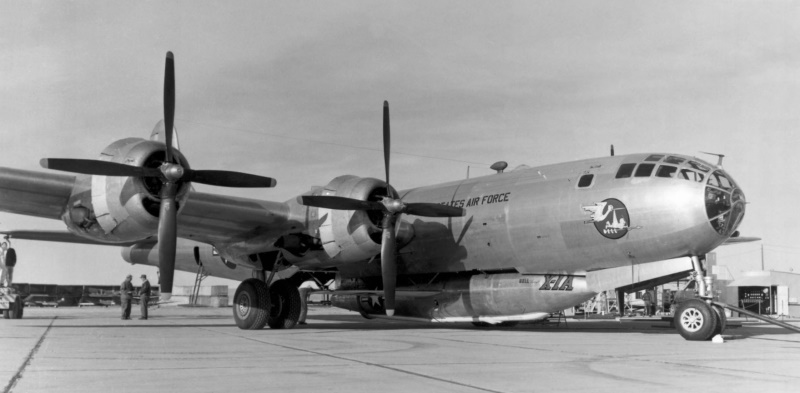
One of the EB-29s was used to carry the McDonnell XF-85 Goblin parasite fighter, a tiny jet fighter to be carried in the belly of a bomber. The Goblin program did not go well; recovering the fighter in flight was tricky, and the Goblin was something of a "toy" in the first place, inspiring no confidence as an adequate fighter aircraft. More productively, EB-29s also served as carrier aircraft for the famous Bell X-1 series of experimental rocket planes, the original X-1 being the first aircraft to break Mach 1 in level flight.
BACK_TO_TOP* Following the end of World War II, the US demobilized rapidly on the belief that nobody was going to be inclined to go to war for some time to come. Besides, the US was the only power that had the Bomb, and who would dare challenge America armed with such a weapon? Few believed that the Soviet Union had the capability of building the Bomb themselves any time soon.
Tensions with the Soviets had been rising since the last year of the war, however, and in 1948 Stalin fired the first "shot" of the Cold War by blockading Berlin, rudely awakening the US from its complacency. The US and Britain were able to rise to the challenge, responding with a massive and well-organized airlift that impressed the Soviets with the material capability of the West. Stalin, his bluff called, lifted the blockade.
He had other cards to play. Although the belief persisted that the USSR wouldn't have the Bomb in the near future, some officials felt that it would be better to be safe than sorry, and so the US Air Force, as the USAAF had become in 1947, equipped some WB-29s with air sampling filters to detect the radioactive fallout from above-ground nuclear tests. These aircraft had hardly gone into operation in 1949 before they detected the airborne debris of a nuclear test, which the Soviets had performed in secret on 29 August 1949.
The US announced on 24 September 1949 that the Soviet Union had detonated their first atomic bomb, which was dubbed JOE ONE. Analysis of the fallout actually gave substantial clues to the design of the weapon -- which was generally a copy of the Fat Man bomb that destroyed Nagasaki, plans having been obtained by Red spies in the atomic bomb program. If the Berlin blockade had been the first wake-up call, the discovery of the Soviet Bomb was the second, and it was even louder.
Ironically, it was the B-29 itself that made the Soviet Bomb an even greater threat. Late in World War II, three B-29s that had been damaged during raids over Japan landed at Soviet bases in Siberia. The American crews had expected that the Soviets would repair the aircraft, fuel them up, and allow them to go home, but the crews were interned. The crews were "allowed to escape" into Iran, jointly occupied by the Soviets and the Western Allies, but their aircraft disappeared.
The USSR lacked an adequate long-range heavy bomber, and Stalin had ordered that the Superfortress be reverse-engineered and put into production as fast as possible. One of the three B-29s was used for flight test, while the other two were carefully taken apart and inspected. The Americans were originally complacent once more, believing that the Soviets didn't have the capability to build an advanced aircraft like the B-29, and were once again rudely surprised to find out they were wrong when the Soviets introduced into service their copy of the Superfortress, the Tupolev Tu-4, which was given the NATO reporting name "Bull".
Although the Tu-4 looked just like a B-29, it wasn't a perfect copy by any means, the Soviets using their own methods and technology as it suited them. For example, the Tu-4 used bag-type fuel tanks, while the 12.7-millimeter Brownings in the gun turrets were changed to harder-hitting 23-millimeter cannon. In any case, the Tu-4 gave the USSR a nuclear delivery capability, though the Tu-4 was inadequate for performing attacks on the continental United States, only able to reach some peripheral cities on one-way missions.
It is believed that about 1,200 Tu-4s were built, with some supplied to Red China. During the 1950s, they were mostly relegated to the transport role, generally being out of service by the early 1960s. The Soviets continued to refine the Tu-4, with its evolution resulting in the famous swept-wing Tu-95 "Bear", one of the most distinctive emblems of Soviet military power.
* In any case, Curtis LeMay had already been responding to the Soviet threat. The B-29 had effectively been America's nuclear delivery platform since the end of the war, but nobody had really been focused on the issue. LeMay was always focused. He became chief of the Air Force's Strategic Air Command (SAC) in 1948, and promptly began to whip SAC into shape, bringing maintenance and training up to scratch and implementing plans for nuclear warfighting.
The first such plan was in place in 1949, and envisioned attacks on 70 Soviet cities, military bases, and other sites with a total of 133 nuclear weapons. Although the Soviets would be hard-pressed to launch attacks on the American mainland with the Tu-4, LeMay had access to bases around the periphery of the USSR that meant Soviet cities were in range of his B-29s. The British Royal Air Force (RAF) also helped keep up the pressure on the Soviets, obtaining a loan of 87 B-29s during the early 1950s to create a British nuclear strike force. They were fitted with some British-specified avionics.
The RAF referred to the Superfortress as the "Washington I". Three of them were actually RB-29s configured for SIGINT duties, being and used to snoop on Soviet installations. The Washingtons were eventually replaced in RAF service by the English Electric Canberra twin-jet bomber. Two of the Washingtons were loaned in turn by the RAF to the Royal Australian Air Force, it appears being fitted with air sampling gear for support of British nuclear tests. The Washingtons were apparently somewhat weary and hard to keep flying; they had all been returned by 1955, except for the three SIGINT machines, which continued in service for a few more years, to then be scrapped. These were the only Superfortresses in foreign service.
The B-29 was the first line of American nuclear offense for the moment, but SAC was already bringing into service the new, bigger Convair B-36, with much longer range and greater payload. It wasn't otherwise any great leap forward over the B-29, but the new, sleek, fast jet Boeing B-47 bomber was being test-flown. The B-29 would not remain America's nuclear delivery system for very long, and by the early 1950s it had been relegated to secondary roles.
* It did, however, see extensive combat once again in the conventional bombing role. In June 1950, North Korea invaded South Korea, beginning a seesaw war in which American and South Korean defenders were pressed back into a corridor around the city of Pusan in the southeast. Following a daring amphibious landing at Inchon, the tables were turned on the North Koreans, and the Americans, assisted by UN forces, threw them back in confusion into North Korea.
The decision was then made to overrun North Korea, but as US forces approached the Chinese border, large numbers of Communist Chinese "volunteers" came across and sent the overextended Americans in flight in turn. The Chinese pursued, believing it was they who would have a total victory, but American resistance solidified on the original North / South Korea demarcation line, and the Chinese offensive was halted by a storm of explosive and steel. By the end of the year, the war had been reduced to a stalemate, not unlike World War I, with the forces trading shots across defensive lines, and making occasional attacks that created produced tremendous casualties for very modest gains. The war ground on into 1953, when a cease-fire was finally signed.
The B-29 was on the front lines of the conflict from almost the first to the last. LeMay originally wanted to conduct another "war of the cities", but this proposal was greeting with what he described as "screams of horror" by his superiors. Apparently the powers-that-be had acquired some pangs of guilt over the destruction of Japan's cities.
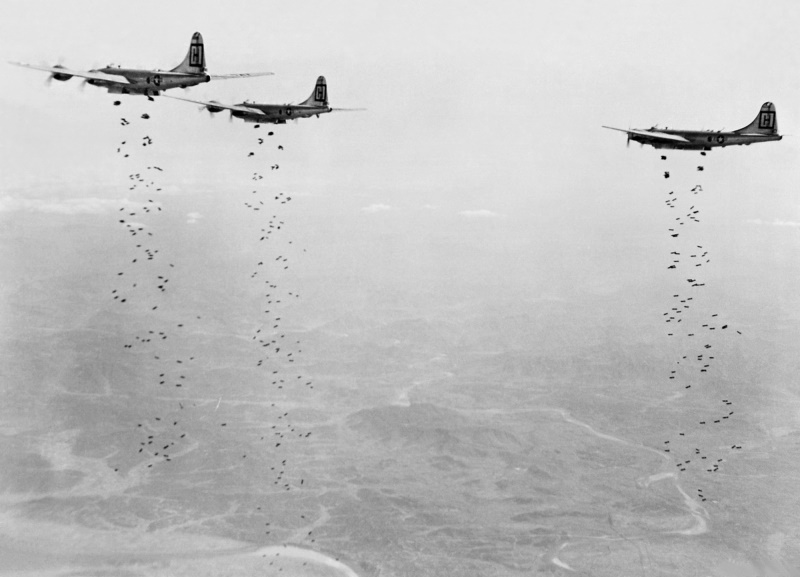
The B-29s were put into service in carpet-bombing North Korean positions around Pusan originally, and hitting militarily significant sites in the enemy's rear, such as railroad yards and supply dumps. When the Chinese intervened in the war, there was a cry to use the Bomb on them, but even LeMay, the ultimate hawk, didn't like the idea. He felt that using a nuclear bomb on dispersed troops in the field would not be very effective, and if it wasn't effective, it might convince America's enemies that the Bomb was a paper tiger. LeMay did suggest that a comprehensive nuclear bombing campaign against China itself would make military sense -- but it was politically out of the question. It was obviously unwise to expand the war to take on China directly, and if the Bomb were used on the Chinese, the Soviets would retaliate in kind against cities in Western Europe.
The B-29s continued to perform conventional bombing attacks to the end of the Korean War, though fighter opposition quickly forced them to stick to night attacks. In late 1950 and early 1951, B-29s carried out attacks with 450-kilogram (1,000-pound) "Razon" radio-guided bombs, to find them too small to do much damage to hard targets; and then the much bigger 5,450-kilogram (12,000-pound) "Tarzon" radio-guided bomb. However, the Tarzon was a very unwieldy store of dubious reliability, and it proved about as much a threat to B-29 crews as it did to the enemy. Guided bombs were something for a later war.
By the time of the cease-fire, B-29s had flown 21,000 sorties, dropped 151,190 tonnes (167,100 tons) of bombs, and claimed the destruction of 33 enemy fighters, including 16 MiG-15 jet interceptors, along with 28 "probables". Although "kill" statistics tend to be exaggerated, sometimes wildly so, loss statistics tend to be reliable, and the USAF lost 34 Superfortresses during the Korean War, with 20 shot down and 14 lost in accidents.
A few Superfortresses were painted black, stripped of all armament except the tail guns, and used to drop agents or leaflets behind enemy lines during the conflict; one of these aircraft was shot down in early 1953, with the 11 crew taken prisoner by the Chinese, to finally be released in 1955.
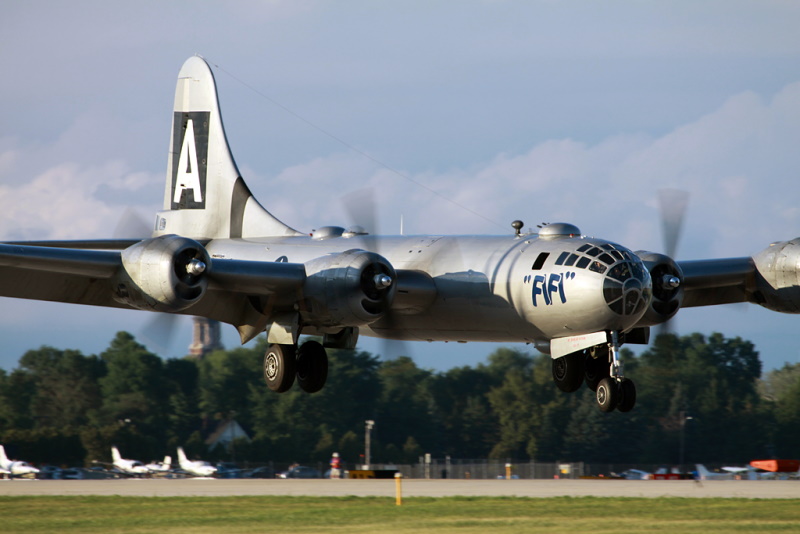
B-29s lingered on in the tanker role into the mid-1950s, with a few used for trials and special missions continuing to fly in military service to the end of the decade. B-29s were not used in civilian roles such as air freight or fire-fighting, most of those that were retired being scrapped. A number of B-29s survive on static display, with two -- named "FIFI" and "DOC" -- still flying on the warbird circuit.
BACK_TO_TOP